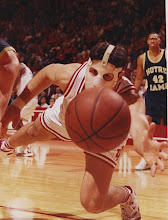For an explanation of CoronaVinyl, click here.
Today's CoronaVinyl category is "comeback album." Everyone loves a comeback story. The man or woman who was once on top, then hit a bad spell, and then made his or her way back to the top. In music, it has happened often. Some examples that come to mind are Tina Turner, who, after separating from Ike, didn't have a lot of solo success and stopped recording between 1979 and 1984, when she released her mega hit album Private Dancer. There was also Aerosmith, who let heroin addiction and in-fighting get the best of them for a few years in the early '80s before their unlikely collaboration with Run-D.M.C. on the 1986 remake of "Walk This Way," which led to the band's comeback album, 1987's Permanent Vacation.I decided to go with Eric Clapton's comeback album, 1974's 461 Ocean Boulevard. As you may know, in the very late '60s and early '70s, Clapton found himself in a moral and emotional quagmire. He was madly in love with Pattie Boyd Harrison -- who happened to be the wife of his best friend, George Harrison. Clapton had formed Derek & The Dominos in 1970 as a way to take himself out of the spotlight (hence the pseudonym "Derek" instead of Eric), but also as a vehicle for him to (not so subtly) profess his love for Pattie through song -- i.e., their lone album, Layla and Other Assorted Love Songs, which is my favorite album ever. While the Dominos were recording, booze and drugs flowed bountifully, and Clapton soon became addicted to heroin. He basically spent the next two years in seclusion shooting up.
In early 1973, The Who's Pete Townshend organized a comeback concert for Clapton, the now-famous Rainbow Concert. It appeared to work, as Clapton came out of hiding. He also started living with Pattie (they would get married in 1979), and, in 1974, Clapton moved to Miami -- specifically, 461 Ocean Boulevard in Golden Beach, just outside Miami -- to record this album.
461 Ocean Boulevard was a departure from the blues-based rock that had made Clapton famous. Instead of focusing on guitar solos and hard-driving rock songs, he made an album that was more laid back. That's not to say it was without blues songs or rock and roll, but it also featured ballads and a few covers, including his cover of Bob Marley's "I Shot the Sheriff," which is considered instrumental in increasing Marley's popularity to mainstream audiences.
The album topped the Billboard album chart and the Canadian album chart, and it also went Top 5 in several other countries. "I Shot the Sheriff" went to #1 on the Billboard Hot 100, and his cover of "Willie and the Hand Jive" went to #26. In addition, songs like "Motherless Children" and "Let It Grow" came to be considered Clapton solo classics.
461 Ocean Boulevard set the stage for what would be a long and successful solo career for Clapton, earning him a Rock and Roll Hall of Fame induction for his solo work and making him the only three-time Rock and Roll Hall of Fame inductee (he was also inducted as a member of The Yardbirds and Cream).
Favorite song from Side 1: "Motherless Children"
Favorite song from Side 1: "Motherless Children"
This is the first track on the album, and it's also my favorite song on the album. It's a traditional blues/gospel song that Clapton turns into an uptempo blues-rock song, showing that, while he may have mellowed, he could still get down.
Favorite song from Side 2: "Mainline Florida"
"Mainline Florida" is the last song on the album, and it has a nice guitar riff, but at the same time has an easy going feel about it. Though this wasn't written by Clapton himself, I have always assumed the "mainline" is an obvious reference to Clapton's prior drug use.
Favorite song from Side 2: "Mainline Florida"
"Mainline Florida" is the last song on the album, and it has a nice guitar riff, but at the same time has an easy going feel about it. Though this wasn't written by Clapton himself, I have always assumed the "mainline" is an obvious reference to Clapton's prior drug use.







No comments:
Post a Comment